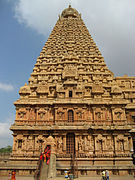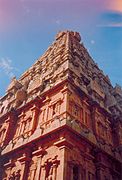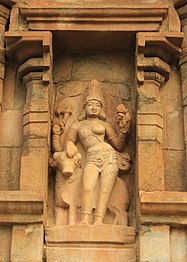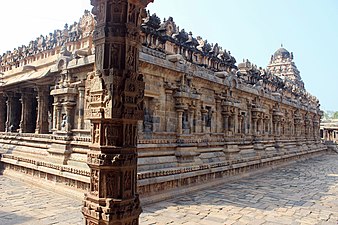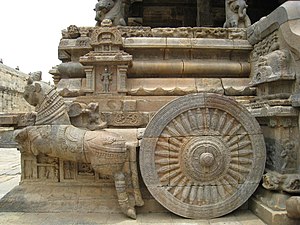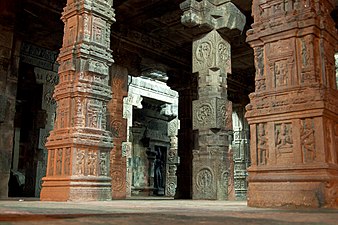
Gaṅgaikoṇḍa Chōḻapuram is a village located near to Jayankondam, Ariyalur district, Tamil Nadu, India. It became the capital of the Chola dynasty in c. 1025 by Chola emperor Rajendra I, and served as the capital for around 250 years.

Ariyalur district is an administrative district, one of the 38 districts in the state of Tamil Nadu in India. The district headquarters is located at Ariyalur. The district encompasses an area of 1,949.31 km2.

Rajendra I, often referred to as Rajendra the Great, Gangaikonda Cholan, and Kadaram Kondan, was a Chola Emperor who reigned from 1014 and 1044 CE. He was born in Thanjavur to Rajaraja I and his queen Vanathi and assumed royal power as co-regent with his father in 1012 until his father died in 1014, when Rajendra ascended to the Chola throne. During his reign, the Chola Empire reached its zenith in the Indian subcontinent; it extended its reach via trade and conquest across the Indian Ocean, making Rajendra one of only a few Indian monarchs who conquered territory beyond South Asia.

The Kailasanathar Temple, Kanchipuram, also referred to as the Kailasanatha temple, is a Pallava-era historic Hindu temple in Kanchipuram, Tamil Nadu, India. Dedicated to Shiva, it is one of the oldest surviving monuments in Kanchipuram. It reflects a Dravidian architecture and was built about 700 CE by Narasimhavarman II with additions by Mahendravarman III. A square-plan temple, it has a mukha-mandapa, a maha-mandapa and a primary garbha-griya (sanctum) topped with a four-storey vimana. The main sanctum is surrounded by nine shrines, seven outside and two inside flanking the entrance of the sanctum, all with forms of Shiva. The outer walls of the temple's prakara (courtyard) is also surrounded by cells.

The period of the imperial Cholas in South India was an age of continuous improvement and refinement of Chola art and architecture. They utilised the wealth earned through their extensive conquests in building long-lasting stone temples and exquisite bronze sculptures, in an almost exclusively Hindu cultural setting.

Thillai Nataraja Temple, also referred as the Chidambaram Nataraja Temple, is a Hindu temple dedicated to Nataraja, the form of Shiva as the lord of dance. This temple is located in Chidambaram, Tamil Nadu, India. This temple has ancient roots and a Shiva shrine existed at the site when the town was known as Thillai. Chidambaram, the name of the city literally means "stage of consciousness". The temple architecture symbolizes the connection between the arts and spirituality, creative activity and the divine. The temple wall carvings display all the 108 karanas from the Natya Shastra by Bharata Muni, and these postures form a foundation of Bharatanatyam, an Indian classical dance.

Dravidian architecture, or the Southern Indian temple style, is an architectural idiom in Hindu temple architecture that emerged from Southern India, reaching its final form by the sixteenth century.
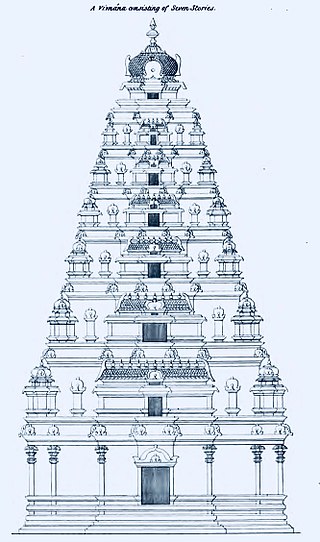
Vimana is the structure over the garbhagriha or inner sanctum in the Hindu temples of South India and Odisha in East India. In typical temples of Odisha using the Kalinga style of architecture, the vimana is the tallest structure of the temple, as it is in the shikhara towers of temples in West and North India. By contrast, in large South Indian temples, it is typically smaller than the great gatehouses or gopuram, which are the most immediately striking architectural elements in a temple complex. A vimana is usually shaped as a pyramid, consisting of several stories or tala. Vimana are divided in two groups: jati vimanas that have up to four tala and mukhya vimana that have five tala and more.

Airavatesvara Temple is a Hindu temple of Dravidian architecture located in Kumbakonam, Thanjavur District in the South Indian state of Tamil Nadu. This temple, built by Chola emperor Rajaraja II in the 12th century CE is a UNESCO World Heritage Site, along with the Brihadeeswara Temple at Thanjavur, the Gangaikondacholisvaram Temple at Gangaikonda Cholapuram that are referred to as the Great Living Chola Temples.

Pazhayarai or Pazhaiyarai or Palayarai was an ancient capital of the medieval Chola dynasty in Tamil Nadu. The place is located around 7 km (4.3 mi) from Kumbakonam, a city in Thanjavur district, in the South Indian state of Tamil Nadu. It is located on the banks of T.Patnam river, one of the distributaries of the river Kaveri. There are a number of villages within the area of historic Pazhaiyarai. The place was called Ayiratalli, meaning a land of thousand temples. The place is referred under various names like Ayiratalli, Pazhayar, Ahavamallakulakalapuram and Minavanaivenkadasolapuram.
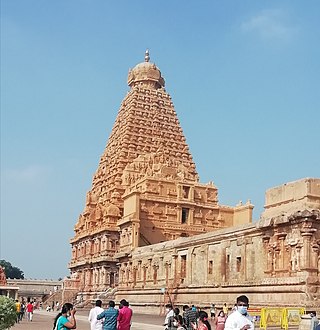
Brihadishvara Temple, called Rajarajesvaram by its builder, and known locally as Thanjai Periya Kovil and Peruvudaiyar Kovil, is a Shaivite Hindu temple built in a Chola architectural style located on the south bank of the Cauvery river in Thanjavur, Tamil Nadu, India. It is one of the largest Hindu temples and an exemplar of Tamil architecture. It is also called Dakshina Meru. Built by Chola emperor Rajaraja I between 1003 and 1010 CE, the temple is a part of the UNESCO World Heritage Site known as the "Great Living Chola Temples", along with the Chola-era Gangaikonda Cholapuram temple and Airavatesvara temple, which are about 70 kilometres (43 mi) and 40 kilometres (25 mi) to its northeast respectively.
Veeramudaiyanatham is a village in Cuddalore district in the Indian state of Tamil Nadu.It is located in near the vallaru(white river),25 km from chidambaram; 23 km from virudhachalam; 80 km from Pondicherry.
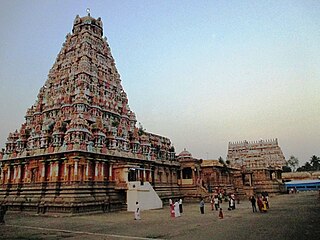
The Kampaheswarar Temple or kampa-hara-ishvarar is a Hindu temple dedicated to the god Shiva. It is situated in Thirubuvanam, a village in Thanjavur district in the South Indian State of Tamil Nadu, on the Mayiladuthurai-Kumbakonam road. Shiva is worshiped as "Kampahareswarar" as he removed the quaking of a king who was being haunted by a Brahmarakshasa. It was built by Kulothunga Chola III and is considered the last of the four masterpieces built during the Medieval Chola era.
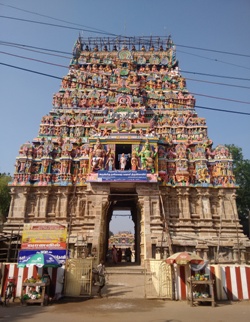
Nageswaraswamy Temple is a Hindu temple dedicated to Shiva located in Kumbakonam in Thanjavur district, Tamil Nadu, India. The presiding deity is revered in the 7th-century Tamil Saiva canonical work, the Tevaram, written by Tamil poet saints known as the nayanars and classified as Paadal Petra Sthalam. The temple is counted as the earliest of all Chola temples. Shiva in the guise of Nagaraja, the serpent king..
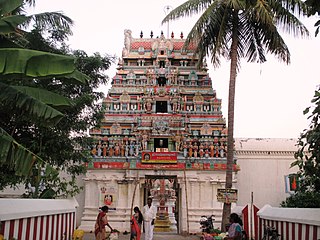
Nathan Kovil or Thiru Nandipura Vinnagaram Temple in Nathan Kovil, a village in the outskirts of Kumbakonam in the South Indian state of Tamil Nadu, is dedicated to the Hindu god Vishnu. Constructed in the Dravidian style of architecture, the temple is glorified in the Nalayira Divya Prabandham, the early medieval Tamil canon of the Alvar saints from the 6th–9th centuries CE. It is one of the 108 Divya Desams dedicated to Vishnu, who is worshipped as Jagannathan and his consort Lakshmi as Shenbagavalli.
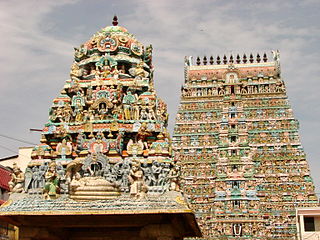
Tamil Nadu is known for its ancient temple architecture. Nearly 33,000 ancient temples, many at least 800 to 2000 years old, are found scattered all over Tamil Nadu. As per Tamil Nadu Hindu Endowments Board, there are 38,615 temples. Most of the largest Hindu Temples reside here. Studded with complex architecture, a variety of sculptures, and rich inscriptions, the temples remain the very essence of the culture and heritage of Tamil land, with historical records dating back to at least 3,000 years.
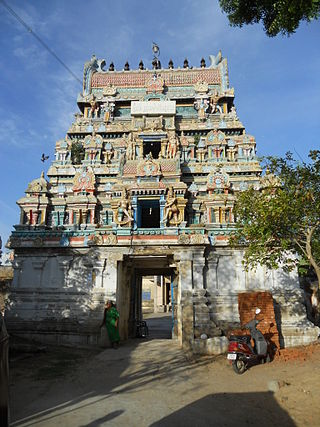
Padikasu Nathar Temple is a Hindu temple located at Azhagaputhur, a village in the Thanjavur district of Tamil Nadu, India. Shiva is worshiped as Padikasunathar, and is represented by the lingam. His consort Parvati is depicted as Soundaranayagi. The presiding deity is revered in the 7th century Tamil Saiva canonical work, the Tevaram, written by Tamil saint poets known as the nayanars and classified as Paadal Petra Sthalam. The 8th century Saiva saint poet Sundarar has sung praise about the temple in his works.

The Hindu Religious and Charitable Endowments Department of the Government of Tamil Nadu manages and controls the temple administration within the state. The Tamil Nadu Hindu Religious and Charitable Endowments Act XXII of 1959 controls 36,425 temples, 56 mathas or religious orders, 1,721 specific endowments and 189 trusts.

The Brihadisvara Temple is a Hindu temple dedicated to Shiva in Gangaikonda Cholapuram, Jayankondam, in the South Indian state of Tamil Nadu. Completed in 1035 AD by Rajendra Chola I as a part of his new capital, this Chola dynasty era temple is similar in design, and has a similar name, as the older 11th century, Brihadeeswarar Temple about 70 kilometres (43 mi) to the southwest in Thanjavur. The Gangaikonda Cholapuram Temple is smaller yet more refined than the Thanjavur Temple. Both are among the largest Shiva temples in South India and examples of Dravidian style temples. The temple is also referred to in texts as Gangaikonda Cholapuram Temple or Gangaikondacholeeswaram Temple

Kapardeeswarar temple is a Hindu temple situated in the village of Thiruvalanchuzhi near Swamimalai in Kumbakonam taluk of Thanjavur district, Tamil Nadu, India. Shiva is worshiped as Kapardeeswarar and is represented by the lingam and his consort Parvati is depicted as Brihannayagi. The presiding deity is revered in the 7th century Tamil Saiva canonical work, the Tevaram, written by Tamil poet saints known as the nayanars and classified as Paadal Petra Sthalam.








